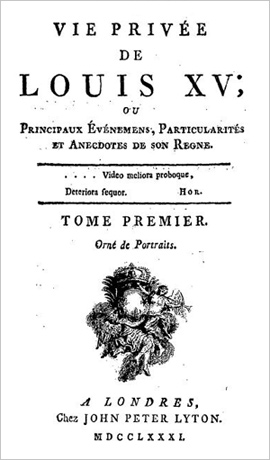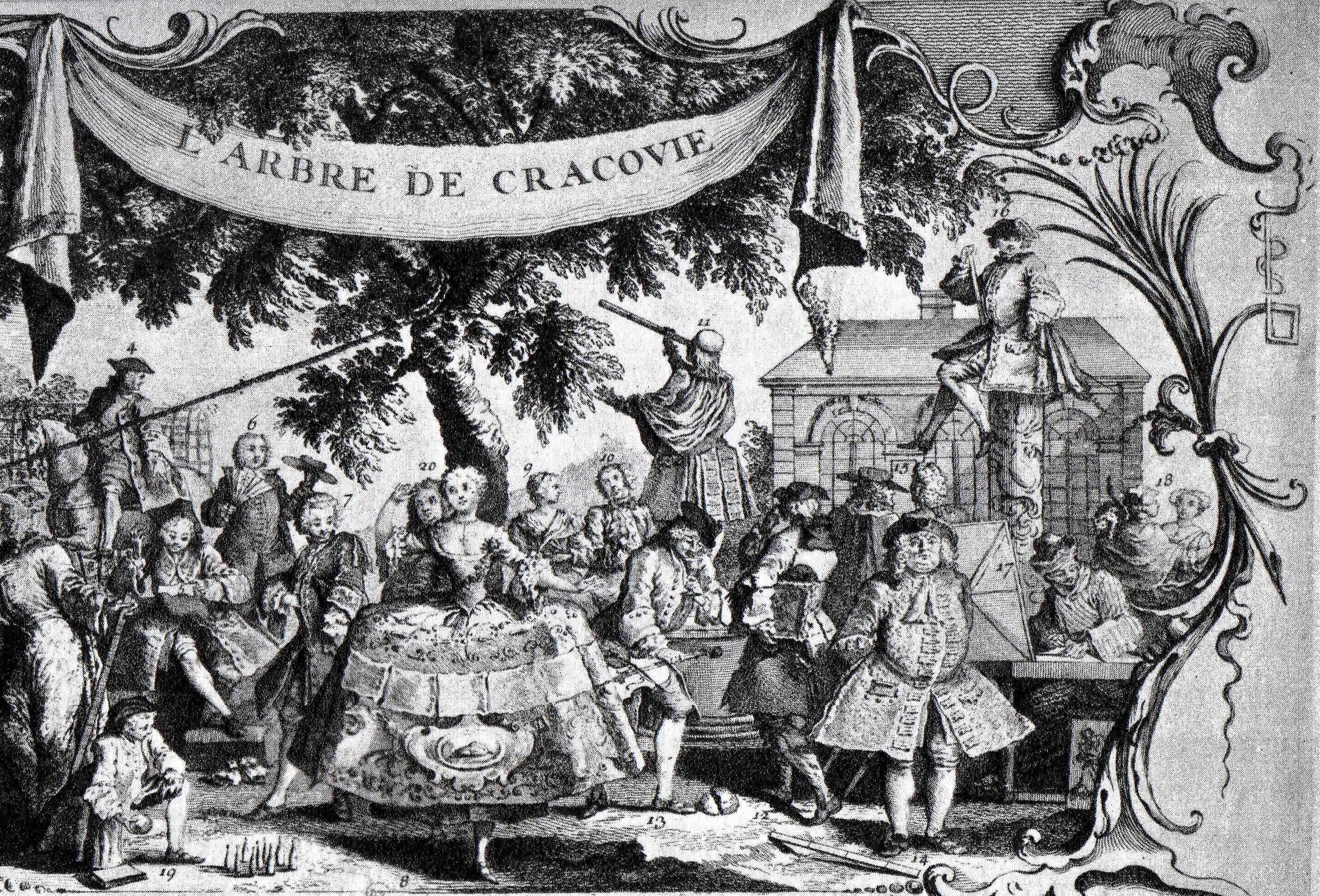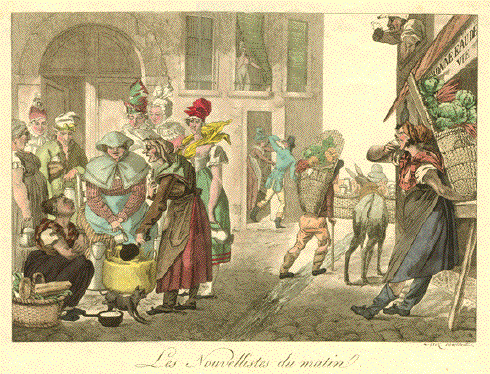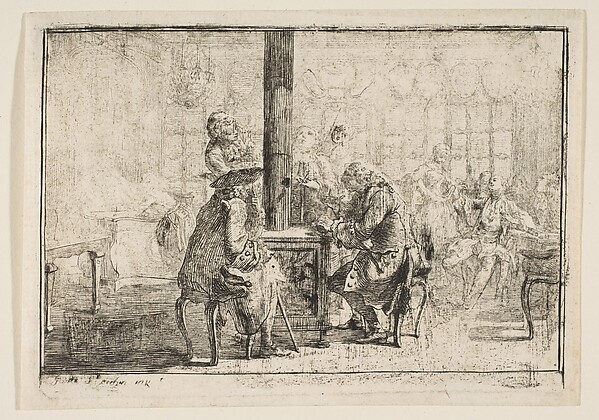 Things have been quiet here for quite a while now but I am hoping to upload a selection of new posts/writings in the next months, both new draft bits of my dissertation and some other writings on books and Open Access. For now I wanted to share my notes on a master class with book historian, librarian, and 18th century specialist Robert Darnton that I attended quite a few months ago now. Part of this master class was a lecture delivered by Darnton entitled ‘Blogging: Now and Then (250 years ago).’ The lecture was based on this blogpost for the NYRB. Also see an interview with Darnton on this subject here.
Things have been quiet here for quite a while now but I am hoping to upload a selection of new posts/writings in the next months, both new draft bits of my dissertation and some other writings on books and Open Access. For now I wanted to share my notes on a master class with book historian, librarian, and 18th century specialist Robert Darnton that I attended quite a few months ago now. Part of this master class was a lecture delivered by Darnton entitled ‘Blogging: Now and Then (250 years ago).’ The lecture was based on this blogpost for the NYRB. Also see an interview with Darnton on this subject here.
 Darnton begins his lecture with declaring that his talk should foremostly be seen as a provocation. A provocation based on, or continuing a line of argument he developed in his book The Devil in the Holy Water (2009). Darnton describes the present experience of information overload as one that makes us feel like we are going through a change just as big as the Gutenberg revolution: the information landscape is changing before our eyes, we are bombarded by information and much of it comes in tiny bites, it comes so fast that we get a blurred vision of what is going on around us. So how to make sense of it all? We could start, Darnton states, by focusing on the fragmented nature of information in general, now and in the past—following the experience of 18th century people. Darnton focuses on scandal or gossip mongering because it can tell us a lot about the medium and the messages that are conveyed and the way information systems operated. Scandal mongering can be seen as an early form of blogging, related to scandal blogging on the Internet. It was not as trivial as one might think. The idea of the anecdote was highly popular in the 18th century: they were everywhere. One could even speak of an anecdotomanie. In this sense it is a seemingly trivial but actually important subject.
Darnton begins his lecture with declaring that his talk should foremostly be seen as a provocation. A provocation based on, or continuing a line of argument he developed in his book The Devil in the Holy Water (2009). Darnton describes the present experience of information overload as one that makes us feel like we are going through a change just as big as the Gutenberg revolution: the information landscape is changing before our eyes, we are bombarded by information and much of it comes in tiny bites, it comes so fast that we get a blurred vision of what is going on around us. So how to make sense of it all? We could start, Darnton states, by focusing on the fragmented nature of information in general, now and in the past—following the experience of 18th century people. Darnton focuses on scandal or gossip mongering because it can tell us a lot about the medium and the messages that are conveyed and the way information systems operated. Scandal mongering can be seen as an early form of blogging, related to scandal blogging on the Internet. It was not as trivial as one might think. The idea of the anecdote was highly popular in the 18th century: they were everywhere. One could even speak of an anecdotomanie. In this sense it is a seemingly trivial but actually important subject.
 In the 16th century Pietro Aretino ridiculed cardinals by pasting sonnets on the Piazza Navona. This was the birth of pasquinades as a genre: pasted pieces of paper on busts. They functioned as bulletin boards in Rome and were filled with short scandalous notices (especially in periods of crisis). This is just one example of how information comes to us in fragments and how it has a fragmentary quality. But how does it fit into a systemic whole? The modern equivalent of a pasquinade, Darnton argues, is the current blog. This comparison, Darnton explains, can be seen as a provocation for rethinking the nature of books, where it, as we shall see, offers a broader vision on the nature of books. To explore this it will be useful to compare today’s scandalous blogs with scandalous anecdotes from the 18th century.
In the 16th century Pietro Aretino ridiculed cardinals by pasting sonnets on the Piazza Navona. This was the birth of pasquinades as a genre: pasted pieces of paper on busts. They functioned as bulletin boards in Rome and were filled with short scandalous notices (especially in periods of crisis). This is just one example of how information comes to us in fragments and how it has a fragmentary quality. But how does it fit into a systemic whole? The modern equivalent of a pasquinade, Darnton argues, is the current blog. This comparison, Darnton explains, can be seen as a provocation for rethinking the nature of books, where it, as we shall see, offers a broader vision on the nature of books. To explore this it will be useful to compare today’s scandalous blogs with scandalous anecdotes from the 18th century.
Darnton compares 18th century anecdotes with modern scandal blogs of the likes of Perez Hilton. He is especially interested in how material is reworked from other blogs: blogging involves recycling of material from other places, including other blogs. This practice was already very common in anecdotes and satiric poetry in the 18th century, were recycling took place from rumor. As Darnton argues, themes from today and the 18th century show close parallels and can be very similar: sex amongst public figures, slander at upper aristocracy and the clergy etc.. However, Darnton argues that we shouldn’t overdue the comparisons—although they work quite well—were historians can always select evidence to make the present look like the past. Darnton states that they are not the same thing and he is not saying that there is a strong continuity between the present and the past. He is interested in understanding what the similarities and dissimilarities are, in order to understand something about information. How do the fragments fit together? These titbits of information do not exist in isolation: they circulate in information systems which are particular to the current time and place and the current communication system. Blogs can help us see how information operates. Scandal bloggers for instance operate in a particular social space opposed to journalism in magazines. This kind of gossip expresses the ‘anxiety and class rage of New York’s creative underclass’. They are living on the edges of the more established journalistic traits.

Darnton first focuses on the similarities. How did information appear in an 18th century newspaper? London had a boom, rough and ready journalistic culture with a daily newspaper already in 1702 (Paris had one in 1777). There were more newspapers in the 18th century then today and their content was often even more scandalous than now. The papers look like a sea of print: 4 columns, and paragraphs are autonomous units. In this sense it is nothing like journalism today were news is delivered in the form of stories and there is a narrative quality to the writing. In the 18th century paragraphs were piled up, unrelated, with no headlines or typographical guidelines. The 18th century was the world of paragraphs. In 1771 reports on parliamentary debates were for the first time tolerated. Political coverage became more expansive which meant the beginnings of a more complex journalism. Before that there was no professional staff, newspapers had no editors or journalists.  Copy came from ‘paragraph man’, who picked up news and gossip from amongst other coffeehouses. The news was written on a slip of paper and brought to a storefront shop or a printing shop were the printer would have a frame and would put the paragraphs in the paper in the order they came in through the letter box. This process was all very primitive compared with today. Coffeehouses functioned like filters for all kinds of news that came in. Bits of papers circulated everywhere along with all sorts of talk in coffeehouses. Basically there were two types of information: oral and written. These types of information came together in the coffeehouse. Print was the third stage. Darnton remarked that Rupert Murdoch is nothing compared to what they were publishing in the 18th century.
Copy came from ‘paragraph man’, who picked up news and gossip from amongst other coffeehouses. The news was written on a slip of paper and brought to a storefront shop or a printing shop were the printer would have a frame and would put the paragraphs in the paper in the order they came in through the letter box. This process was all very primitive compared with today. Coffeehouses functioned like filters for all kinds of news that came in. Bits of papers circulated everywhere along with all sorts of talk in coffeehouses. Basically there were two types of information: oral and written. These types of information came together in the coffeehouse. Print was the third stage. Darnton remarked that Rupert Murdoch is nothing compared to what they were publishing in the 18th century.
In 1772 reverend Henry Bate, editor of the Morning Post—which specialised in scandal mongering—, was challenged by his victims to a duel. Bate, being a great fighter, won the duel! He founded the Morning Herald after a quarrel with the owner of the Post, reverend William Jackson, also known as Dr. Viper. It is interesting to see, Darnton remarks, how in the 18th century two men of the cloth slug it out in their newspapers making scandal and sensationalism a stable ingredient of British journalism.
 In 18th century France scandal mongering took the form of anecdotes, which were represented in pamphlets, literature and books. They were the equivalent of the English paragraph. The word had a special connotation, namely the opposite of what it suggests today. Today we understand paragraphs as brief accounts of trivial incidents and we don’t give them much credence (like anecdotal evidence, evidence that is probably not true, not confirmed and probably false). In the 18th century it referred to something that was true but that was kept secret or was suppressed (by previous historians). A kind of secret history, like for instance the anecdotes of Procopius. The word anecdote was used to signify the secret history of facts that happen in the inner courts of cabinets covering the mystery of their politics. Politics was seen as something secret then, as a private thing. It was hidden from the public, part of the secret sphere (le secret de roi). The personal depravity an anecdote represents is a symbol for the state of the empire. The Procopian strain in history wants to expose the true story of the secret elements that determine the true course of events, the secret story that is hidden by official history. 18th century examples are The private life of Louis XV and Anecdotes about Madame de Contesse du Barry. Anecdotes were often understood to be half-truths, and they often presented themselves as this. This was part of a rhetorical game, a game between the author and the reader.
In 18th century France scandal mongering took the form of anecdotes, which were represented in pamphlets, literature and books. They were the equivalent of the English paragraph. The word had a special connotation, namely the opposite of what it suggests today. Today we understand paragraphs as brief accounts of trivial incidents and we don’t give them much credence (like anecdotal evidence, evidence that is probably not true, not confirmed and probably false). In the 18th century it referred to something that was true but that was kept secret or was suppressed (by previous historians). A kind of secret history, like for instance the anecdotes of Procopius. The word anecdote was used to signify the secret history of facts that happen in the inner courts of cabinets covering the mystery of their politics. Politics was seen as something secret then, as a private thing. It was hidden from the public, part of the secret sphere (le secret de roi). The personal depravity an anecdote represents is a symbol for the state of the empire. The Procopian strain in history wants to expose the true story of the secret elements that determine the true course of events, the secret story that is hidden by official history. 18th century examples are The private life of Louis XV and Anecdotes about Madame de Contesse du Barry. Anecdotes were often understood to be half-truths, and they often presented themselves as this. This was part of a rhetorical game, a game between the author and the reader.
 Where did anecdotes originate? Their main sources were rumor and public noises, collected from for instance London coffee places. In France there were les nouvellistes, newsmen who would station themselves in a café or at another crucial place in the oral network (gardens, parks). Underground books where sold here (amongst others around the tree of Cracow in the gardens of the Palais Royal, a place were prostitution and gambling were also not unknown). Nouvellistes would listen to the gossip and would then write it down in straps of paper (like the paragraph man). He would then go to a garret to transcribe them into manuscript newssheets. They were then copied and sold. There was a whole industry around conveying news in anecdotes. Although it was strictly speaking illegal, moderate nouvellistes where tolerated (and there was even some collaboration with the police sometimes). The echo of public noises in these examples illustrates the importance of oral information as a source of news. The French did not have something as ‘progressive’ as the English press, their newspapers could not discuss the affairs of the state. There was a lot of censorship, even of Dutch newspapers, which were distributed in the French realm. Censorship also took place of the distribution systems surrounding the anecdotes. Nouvellistes where arrested sometimes and frisked for pieces of paper in their pockets.
Where did anecdotes originate? Their main sources were rumor and public noises, collected from for instance London coffee places. In France there were les nouvellistes, newsmen who would station themselves in a café or at another crucial place in the oral network (gardens, parks). Underground books where sold here (amongst others around the tree of Cracow in the gardens of the Palais Royal, a place were prostitution and gambling were also not unknown). Nouvellistes would listen to the gossip and would then write it down in straps of paper (like the paragraph man). He would then go to a garret to transcribe them into manuscript newssheets. They were then copied and sold. There was a whole industry around conveying news in anecdotes. Although it was strictly speaking illegal, moderate nouvellistes where tolerated (and there was even some collaboration with the police sometimes). The echo of public noises in these examples illustrates the importance of oral information as a source of news. The French did not have something as ‘progressive’ as the English press, their newspapers could not discuss the affairs of the state. There was a lot of censorship, even of Dutch newspapers, which were distributed in the French realm. Censorship also took place of the distribution systems surrounding the anecdotes. Nouvellistes where arrested sometimes and frisked for pieces of paper in their pockets.
 Anecdotes were collected into journals and scrapbooks. These papers of anecdotes fascinated people; it was their source of news. Although it seems trivial, they are an important subject of study, as they convey how information followed a consistent pattern trough the media of diffusion of the time, from oral to written circles of information and how it then appeared in print (and was distributed). Anecdotes were also combined in books: sometimes even into 36 volumes. Mostly these were collages of anecdotes lifted from other works, cobbled together to form a continuous anecdote. Anecdotes are thus units of information that pass from one work into another. In books passages from other books are cobbled together following a cut and paste logic: chunks of information were put together as if they were a mosaic. These books thus became a repertory of anecdotes that were passed on from one book to the next.
Anecdotes were collected into journals and scrapbooks. These papers of anecdotes fascinated people; it was their source of news. Although it seems trivial, they are an important subject of study, as they convey how information followed a consistent pattern trough the media of diffusion of the time, from oral to written circles of information and how it then appeared in print (and was distributed). Anecdotes were also combined in books: sometimes even into 36 volumes. Mostly these were collages of anecdotes lifted from other works, cobbled together to form a continuous anecdote. Anecdotes are thus units of information that pass from one work into another. In books passages from other books are cobbled together following a cut and paste logic: chunks of information were put together as if they were a mosaic. These books thus became a repertory of anecdotes that were passed on from one book to the next.
 However, it was hard to see this as plagiarism: these authors were compilers and they published anonymously. They are also not disguising their plagiarism, they are hack writers who are putting together secret histories. Theirs is a form of creative bricolage. The conventional concept of authors or books, Darnton argues, do not fit this vision of cultural production. Nor does it fit the future, Darnton claims. He quotes Kevin Kelly: ‘once digitised books can be reduced to snippets of a page and remixed into new ones’. Larry Lessig similarly argues that we life in a cut and past culture. Bricolage is inherent in many kinds of culture. As Marcus Boon has argued in In praise of copying, fragmentation and montage is a minor concern of contemporary culture where ‘copying is a fundamental part of being human.’ Benjamin and Barthes already argued that the fragmentary quality of modernist literature is the modernist way of perceiving the world.
However, it was hard to see this as plagiarism: these authors were compilers and they published anonymously. They are also not disguising their plagiarism, they are hack writers who are putting together secret histories. Theirs is a form of creative bricolage. The conventional concept of authors or books, Darnton argues, do not fit this vision of cultural production. Nor does it fit the future, Darnton claims. He quotes Kevin Kelly: ‘once digitised books can be reduced to snippets of a page and remixed into new ones’. Larry Lessig similarly argues that we life in a cut and past culture. Bricolage is inherent in many kinds of culture. As Marcus Boon has argued in In praise of copying, fragmentation and montage is a minor concern of contemporary culture where ‘copying is a fundamental part of being human.’ Benjamin and Barthes already argued that the fragmentary quality of modernist literature is the modernist way of perceiving the world.
 Darnton thus suggests that we imagine authors in the 18th century as selectors, selecting bits and pieces from all kinds of books to make new books. The most important unit was the anecdote, which was the basis of information. We should re-envision the history of information, Darnton argues, by beginning with the fragment. Anecdotes can perhaps tell us some valuable lessons about public opinion (were scandal is a crucial ingredient in public opinion), but also about the fragmentary nature of information and the way it is reworked in communication systems. These have differed in history, meaning that in this respect anecdotes and blogs are not the same thing. But by noticing their similarity, Darnton claims, we can see their difference: they both work via fragments, but we need to explore how these fragments function differently within a certain information ecology.
Darnton thus suggests that we imagine authors in the 18th century as selectors, selecting bits and pieces from all kinds of books to make new books. The most important unit was the anecdote, which was the basis of information. We should re-envision the history of information, Darnton argues, by beginning with the fragment. Anecdotes can perhaps tell us some valuable lessons about public opinion (were scandal is a crucial ingredient in public opinion), but also about the fragmentary nature of information and the way it is reworked in communication systems. These have differed in history, meaning that in this respect anecdotes and blogs are not the same thing. But by noticing their similarity, Darnton claims, we can see their difference: they both work via fragments, but we need to explore how these fragments function differently within a certain information ecology.

Leave a Reply
You must be logged in to post a comment.